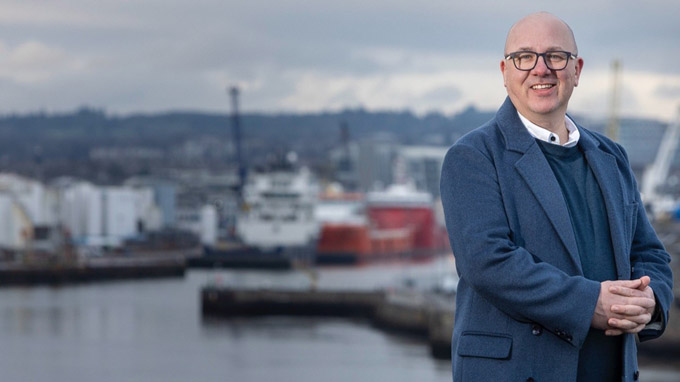Balancing Investment, Reality, and Responsibility

By David Sheret
Navigating Pressure with Perspective
If you run or advise an energy business—whether it’s a service company in Montrose or a tech scale-up in Singapore—you’re probably facing the same pressures: rising costs, growing scrutiny, and conflicting signals from policy, clients, and capital.
This is not just transition in theory. This is transition in the trenches.
In the offshore sector, we are being asked to move faster, decarbonise harder, and still deliver the same reliability we've always promised. The risk is that we’re caught between two extremes: frozen by complexity or swept up in oversimplification.
We need a third way—measured, pragmatic, and honest.
A Transition That Reflects Reality
At SEO, we use the phrase “just and sensible” deliberately. We believe the offshore energy transition must do two things simultaneously:
- Decarbonise with credibility
- Protect energy security and economic stability
This means acknowledging that oil and gas—especially offshore—remain essential. They fund national budgets, provide jobs, and underpin grid reliability. At the same time, renewables—particularly offshore wind and floating platforms—are scaling faster than forecast and attracting most of the new capital.
The question isn’t “which side are you on?”
It’s “how do we build a bridge between them?”
Capital Flows Are Changing—But Not Equally
According to the IEA’s World Energy Investment 2025 report, global energy investment is forecast to reach $3.3 trillion this year. Over two-thirds of that will go to clean energy—including offshore wind, electrification, grids, and low-carbon fuels.
But this isn’t a global story.
Over 50% of that capital is going to just three places: China, the U.S., and the EU.
If you're operating in Suriname, Southeast Asia, the Middle East, or even parts of the UK supply chain, you may not feel that boom. You're more likely feeling project delays, cautious procurement, and investor hesitation.
Why? Because ports, fabrication yards, vessels, and HVDC cables don’t move quickly. And neither does capital when confidence is weak.
If we want a fair energy transition, we must finance not just the generation—but the infrastructure that supports it.
UK Offshore Wind: AR7 Must Deliver
The UK’s AR7 auction, scheduled for 7–27 August 2025, is a clear inflection point. After a subdued AR6, where only 5 GW was awarded, AR7 must now deliver at least 6 GW to maintain credibility.
Siemens Energy has been candid: without a clear pipeline, manufacturing investment stalls. Hull’s turbine facility—assembling 100-metre blades—is watching this auction closely, as are every OEM and Tier 2 supplier from Aberdeen to Hull.
For SMEs and service providers, the message is simple:
- If AR7 succeeds, the UK offshore wind supply chain will breathe easier.
- If it doesn’t, it may lose talent, capital, and market share to faster-moving jurisdictions.
Gas and LNG: Is the Window Still Open?
This week’s Wood Mackenzie Gas & LNG conference raises a critical point. Is gas still a transition fuel, or has the window begun to close?
In Asia, LNG demand is growing—India, Vietnam, and Bangladesh are expanding import capacity. In Europe, it’s a strategic buffer. But for new projects, the investment case is tightening. ESG mandates are sharper. Inflation is biting. Long-term offtake is harder to secure.
If you operate in or around LNG, the imperative is clear:
Clean up emissions, adopt transparent reporting, and integrate CCUS. Or risk being priced—and regulated—out.
Emerging Producers: The Suriname Model
Suriname’s Staatsolie is seeking $1.5 billion to participate in the Gran Morgu offshore development, led by TotalEnergies and APA. Their aim? Not just revenue—but capability.
This is a playbook for other state-owned or mid-cap operators:
- Partner early
- Negotiate local content
- Use the deal to build technical and financial capacity
Emerging producers must not be left behind in the global capital race. But neither can they wait for perfect conditions. Strategic sovereignty starts with informed, early engagement.
Execution > Evangelism in Offshore Wind
The upcoming Global Offshore Wind 2025 conference (17–18 June, London) carries the slogan: “Mission: Possible.”
It is. But only if we get real about the challenges:
- Permitting: Projects still face multi-year delays.
- Inflation: Steel, labour, and logistics costs continue to climb.
- Supply Chains: Turbines, cables, vessels, and substations are at capacity.
For operators and OEMs alike, now is the time to invest in pre-screening, contracting discipline, and talent pipelines—not just technology demos.
Don’t Forget Safety: Renewables Can Learn from Oil & Gas
One of the offshore oil and gas sector’s greatest contributions is a culture of safety and operational integrity. From Piper Alpha to Deepwater Horizon, the industry has learned—often painfully—how to manage complexity.
Floating wind, hybrid marine structures, and tidal systems now face their own safety learning curve. The same rigour that governs DSVs and FPSOs must govern turbine installation, mooring integrity, and technician safety.
This isn’t a regulatory tick-box—it’s a mindset.
Supply Chains and Workforce: The Real Bottlenecks
- The workforce is ageing.
- The cable yards are at capacity.
- The permitting offices are under-resourced.
Transition is not just a technology challenge. It’s a logistics and labour challenge. SMEs and operators must plan for:
- Cross-training oil and gas crews for offshore wind work
- Building localised supply chain hubs in emerging markets
- Navigating geopolitical risk around key materials like rare earths and HVDC cables
Policy needs to keep up. And so does strategy.
Final Word: Clarity Before Capital
At SEO, we work with clients before they raise, before they sell, and before they appoint an M&A adviser.
Why? Because clarity beats speed.
If you're operating in this market and unsure of whether you're investor-ready, whether your value proposition is understood, or whether your transition narrative holds up—talk to David Sheret. david@sheret.net
KeyFacts Energy Industry Directory: Sheret Energy Offshore
 KEYFACT Energy
KEYFACT Energy